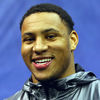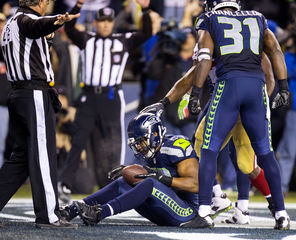Originally published January 29, 2014 at 12:40 PM | Page modified March 5, 2014 at 12:04 PM
Malcolm Smith makes fast tracks despite illness, draft snub
Seahawks linebacker Malcolm Smith saw his weight inexplicably drop along with his draft position, but a diagnoses of his disorder has helped make him one of Seattle’s most versatile players.
Seattle Times staff reporter
Mike Siegel / The Seattle Times
Malcolm Smith cradles the ball he intercepted in the play against the San Francisco 49ers that sent the Seattle Seahawks to the Super Bowl.

Outside linebacker Malcolm Smith (#53) of the Seattle Seahawks talks with the media during Super Bowl XLVIII Media Day at the Prudential Center on Jan. 28, 2014 in Newark, N.J. Super Bowl XLVIII will be played between the Seattle Seahawks and the Denver Broncos on Feb. 2. (Photo by Elsa / Getty Images)
![]()
JERSEY CITY, N.J. – The Seahawks preach a simple mantra to their defense — good things happen to those who run.
And even when linebacker Malcolm Smith questioned his future, he has always been able to run.
“He’s a weapon,” linebackers coach Ken Norton said. “He has speed.”
Which is why Smith was in position to make maybe the most famous interception in Seahawks history, catching a pass in the end zone intended for San Francisco’s Michael Crabtree. The ball was tipped into his hands by Richard Sherman, sealing Seattle’s win and clinching a trip to Super Bowl XLVIII.
“Run to where the ball is going because there is a high probability that the ball is going to be tipped and you are going to be there to make the play,” Norton said of what Seattle’s linebackers are instructed to do on pass plays. “And he did that day.”
Even if a lot of people might barely have noticed, with attention focused on Sherman’s tip and postgame interview.
Smith says life hasn’t changed much since that play, other than the obvious fact that he’s preparing for the Super Bowl.
Smith said he hopes the play changes one thing — doubts about his place in the NFL.
Smith, who is completing his third season, is the jack-of-all trades for Seattle’s linebacking corps. Yet his pro football career began with Smith’s weight plummeting because of a mystery illness and his draft position falling just as fast. He fought back, and began the season as a starter at strongside linebacker when Bruce Irvin served his four-game suspension for using performance-enhancing drugs.
When Irvin returned, Smith briefly moved back to the bench. But when middle linebacker Bobby Wagner missed two games with an ankle injury, Smith started at weakside linebacker as K.J. Wright moving to Wagner’s spot. After Wagner returned, Smith went back to a reserve role, until again moving into the starting lineup when Wright broke his foot against San Francisco.
In all, Smith has started 16 games, including both playoff contests. He carved out a reputation for making big plays, including an interception return for a touchdown to spark the season-ending win against the Rams.
“He can step in at any of the positions and he’s as good or better than the guy in front of him,” Norton said.
Eventually, Smith wants to be more than the guy stepping in for someone else. For now, he’ll take it, considering the uncertainty he felt when he left USC after the 2010 season.
Smith, the younger brother of former USC All-American receiver Steve Smith, was drafted in the seventh round in 2011 with the 242nd overall pick. That actually was higher than he braced himself for after not being invited to the NFL combine, a sting that still lingers.
He finished with a solid, if unspectacular, career at USC, where he played his first three years for Pete Carroll before Carroll left USC for Seattle and Lane Kiffin took over.
First, though, Smith had to endure a few unsettling months in 2009 when he was diagnosed with achalasia, a rare disease that makes swallowing, and therefore eating, difficult. The disease was discovered after Smith mysteriously lost about 30 pounds.
Surgery helped, but Smith still deals with the illness daily. He has to restrict his diet and eat in small portions with lots of water.
“It’s just different for me than a lot of people,’’ Smith said Wednesday.
Smith thinks his condition might have contributed to the lack of NFL interest in 2011. Carroll and Norton, though, gave him a chance, and after initially playing primarily on special teams, Smith has seen his role increase.
“Early in his career, his issue was just being durable,’’ Norton said. “But he’s really grown up, really matured.”
No one questioned Smith’s understanding of his role on the field. When the 49ers reached the Seattle 18-yard line in the final minute of the NFC Championship Game, Smith saw Crabtree lined up wide, the only receiver on his side of the field.
“Against our defense, teams like to attack that single-side receiver,” Smith said.
He recognized exactly what to do — make 49ers quarterback Colin Kaepernick throw higher, not simply throw to Crabtree’s back shoulder.
“He threw the ball high like we would want him to,” Smith said. “And then Sherm tipped it and I caught it.”
No big deal.
“It’s something we work on so much that it’s kind of second nature,” he said matter-of-factly.
Smith tossed the ball away, not realizing he might want a memento of his role in one of the most famous plays in Seattle sports history. He got it later.
“I’ll probably just give it to my dad, something like that,” Smith said.
Maybe, he says, there’s a bigger memento to come.
“We’ve got one more big game to win,” he said. “So there’s the possibility there could be another interception to top mine.”
Bob Condotta: 206-515-5699 or bcondotta@seattletimes.com.
On Twitter @bcondotta
 Four weeks for 99 cents of unlimited digital access to The Seattle Times. Try it now!
Four weeks for 99 cents of unlimited digital access to The Seattle Times. Try it now!














